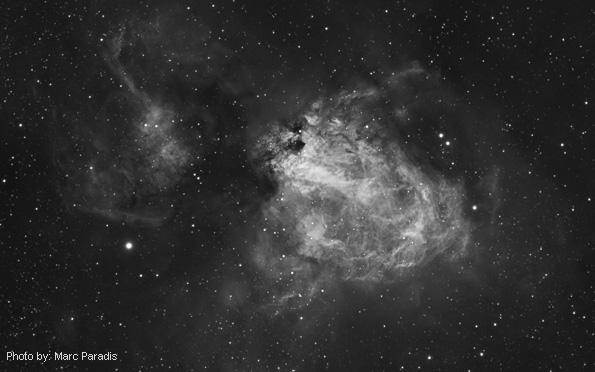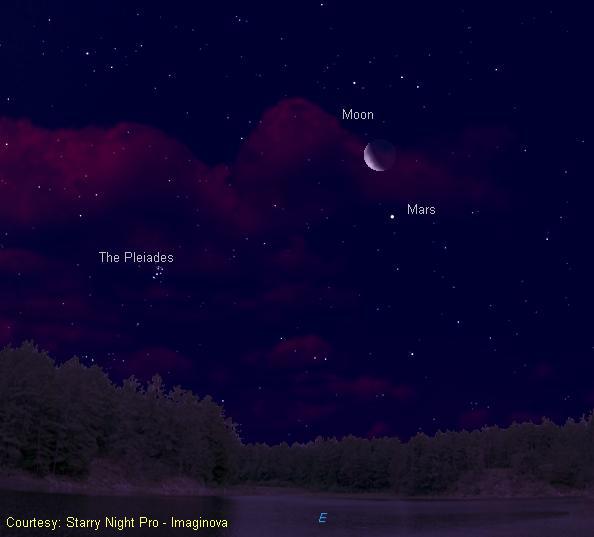The Archer’s Many Targets
As the starry sky slowly changes from night to night, we have a small observing window when scrutinizing the lowermost constellations. Opposed to the Big Dipper that is seen all year round, Sagittarius the Archer appears low in the south skies for a few hours per night. With so many interesting open and globular clusters to hunt down, we definitely have our work cut out.
To fully appreciate the majesty of the night, head out to the countryside and prepared to be dazzled. Looking at Sagittarius as well as the eastern half of Scorpius, there appears to be a misty haze amongst the distant stars. This cosmic haze is the glow of literally millions of suns that occupy the nucleus of our Milky Way Galaxy.
As you wait for the sky to darken, swing over to the king of planets. Mighty Jupiter is already up in the southeast as the Sunsets. It crosses the meridian (highest point in the sky) in the south around 11 p.m. locally at the beginning of July and 9 p.m. by month’s end. Over the past few years, Jupiter’s belts and zones have undergone slight changes in appearance. Now the equatorial zone has somehow darkened. If you have not seen this giant planet through a telescope – what are you waiting for?

Each night will show a completely different orientation of the four main Galilean moons and in fact, an elapsed hour will show subtle positional change. A complete timetable of Jupiter’s moons crossing the planet along with their shadows is found in the 2007 edition of the RASC handbook.
While on the topic of planets, Venus is now moving closer to us in its orbit around the Sun. Its half-lit phase is slowly getting larger and is creeping to the crescent variety. Venus is completely covered in clouds and is the reason for its great brilliance. To the right of Venus and slipping into twilight is Saturn. Hunt for it as soon as you spot it as we are now on borrowed observing time.
One of my favourite globular clusters in Sagittarius is M22. Located some two and a half degrees to the upper left of the top star named Kaus Borealis of the Archer’s asterism (a teapot), is a beautiful concentration of distant suns. Situated at more than ten thousand light-years (ly) away, M22 houses an estimated 100,000 stars. This cosmic snowball was first discovered by Abraham Ihle back in 1665. At magnitude 5.2, it can be picked up without optical aid.
Within the confines of Sagittarius lie a couple of stellar incubators. One is called the Lagoon Nebula and given the catalogue number M8. An easy way to locate the Lagoon is to first locate the spout of the Tea Pot. You are now at Alnasl, which is located a mere 96 ly away. Its brightness equals 64 times that of the Sun and its K0 classification relates to a surface temperature of 4800 degrees Kelvin. Alnasl’s radius is 12 times that of Sol and twice the mass. Now move a bit more than six degrees (twelve lunar diameters) north until you come across a hazy patch. This can be seen from the suburbs with binoculars and naked eye from darks locals.
M8 resides about 5,000 ly away and takes up two lunar diameters of sky. The hydrogen gas cloud is being lit up by hot, infant stars giving off a lot or. In fact, the same wide-angle field of view will reveal a very young cluster of stars about a million years old. Keep on your northern trek and you will catch M20 aka the Trifid Nebula. Photos reveal a nice impression of a flower petal of red and blue. Also at 5,000 ly, the Trifid is considered an open cluster with nebulosity.
The next cosmic maternity ward is M17. It has a few names associated with is. The Omega Nebula is the most use but others such as the Swan, Horseshoe and even the Lobster from observers in the southern hemisphere, are widely used. Any way you say it, this beautiful shell of interstellar gas and dust is forming an estimated 35 stars which are embedded deep in the nebulosity and not readily resolved. The very young stars are causing the region to glow. Marc Paradis of Ancienne-Lorette, Quebec took this luminance shot of M17. Notice the fine detail in the star-forming clouds. Excellent image Marc.

Ptolemy’s cluster (M7) is large, scattered and shines at magnitude 3.8. This open cluster is bright enough to reflect off a calm lake. What a sight in any optical instrument. In fact, there are so many open and globular clusters, wide-angle binoculars could be your only visual aid. However, a telescope had the resolving power. With binoculars, you can hunt down numerous dark clouds that block backlit stars. You will need dark skies and very clear south. One good star chart for nailing down these dark objects is the Skalnate Pleso which I have owned since the 1970s. Even in the hi-tech world, you still can’t replace the old faithful star charts.
Let’s take a few moments and hop over to Scorpius. The orangey coloured star called Antares is listed at magnitude 1.1 and is the 13th brightest star in the sky. At a distance of about 600 ly, this supergiant star that is so large, if we replaced it with the Sun its boundaries would end somewhere between the asteroid belt and mighty Jupiter. Moving one and a quarter degrees to the west of Antares is M4, a magnitude 5.6 globular cluster. This loose cluster by nature is estimated to be 7,200 ly from us and close to 75 ly wide. It takes up a little more than the area of the full Moon and contains 43 known variable stars.
Move up halfway to the top claw and find M80. This is one of the densest globulars in the sky. Large scopes are needed to resolve stars to the center. This 8th magnitude cluster has a diameter of around 90 light-years and is estimated to be some 36,000 ly from us. It is pretty rare to hear of a nova in a globular cluster but this was the case in 1860. Another nova occurred in 1938 but was only viewed photographically.
One of the prettiest open clusters is M11 which is buried in the Scutum star cloud. Commonly known as the Wild Duck Cluster, M11 contains an estimated 500 stars brighter than 14 magnitude. Looking at this object in a telescope, you will see a bright star close to the middle of the cluster. This single star is simply in the line of sight and not part of the target of M11. Not all globular clusters stand out to be viewed. For a challenge, try NGC 6356. Sitting at close to 50,000 ly, the cluster cannot be resolved into individual stars. By comparison, close by M9 is about half the distance from the Sun.
A nice lunar portrait will occur on July 10th at 3:30 a.m. eastern time. At this early hour, M45 – the Pleiades cluster is rising with the crescent moon to the two o’clock position and 26 degrees away along with Mars to the south.
The observing window when the brilliant moon will not interfere will be from the 8th to the 20th. Now we can look at the rugged lunar features from night to night along the terminator (dividing line between the lit and unlit areas). In fact, July 20th will mark the 38th anniversary of humans walking on the Moon. This was the turning point of the space race and the development of miniature computers. The full Buck moon occurs on July 29th at 20:48 eastern time.

| Object | Type | Magnitude | RA | DEC |
|---|---|---|---|---|
| M 04 | Globular cluster | 5.9 | 16h 24m | -26d 33m |
| M 08 | Emission nebula | 5.8 | 18h 04m | -24d 23m |
| M 09 | Globular cluster | 7.9 | 17h 19m | -18d 31m |
| M 10 | Globular cluster | 6.6 | 16h 57m | -04d 06m |
| M 11 | Open cluster | 5.8 | 18h 52m | -06d 16m |
| M 12 | Globular cluster | 6.6 | 16h 47m | -01d 58m |
| M 14 | Globular cluster | 7.6 | 17h 38m | -03d 15m |
| M 16 | Emission nebula | 6.0 | 18h 19m | -13d 47m |
| M 17 | Emission nebula | 6.0 | 18h 21m | -16d 11m |
| M 18 | Open cluster | 6.9 | 18h 21m | -17d 08m |
| M 19 | Globular cluster | 7.2 | 17h 03m | -26d 16m |
| M 20 | Emission nebula | 6.3 | 18h 02m | -23d 02m |
| M 26 | Open cluster | 8.0 | 18h 46m | -09d 24m |
| M 54 | Globular cluster | 7.7 | 18h 55m | -30d 28m |
| M 62 | Globular cluster | 6.6 | 17h 01m | -30d 07m |
| M 69 | Globular cluster | 7.7 | 18h 31m | 32d 20m |
| M 70 | Globular cluster | 8.1 | 18h 43m | -32d 17m |
| M 80 | Globular cluster | 7.2 | 16h 17m | -23d 00m |
| M107 | Globular cluster | 8.1 | 16h 32m | -13d 04m |
| NGC 6293 | Globular cluster | 8.2 | 17h 11m | -26d 36m |
| NGC 6304 | Globular cluster | 8.4 | 17h 18m | -29d 29m |
| NGC 6356 | Globular cluster | 8.4 | 17h 24m | -17d 49m |
| NGC 6522 | Globular cluster | 8.6 | 18h 04m | -30d 02m |
| NGC 6604 | Open cl with nebulosity | 6.5 | 18h 19m | -12d 14m |
| NGC 6605 | Open cluster | 6.0 | 18h 18m | -14d 59m |
| NGC 6624 | Globular cluster | 8.3 | 18h 24m | -30d 22m |
| NGC 6641 | Globular cluster | 7.4 | 17h 51m | -37d 03m |
| NGC 6642 | Globular cluster | 8.8 | 18h 32m | -23d 29m |
| NGC 6649 | Open cluster | 8.9 | 18h 34m | -10d 24m |
| NGC 6664 | Open cluster | 7.8 | 18h 37m | -08d 13m |
| NGC 6723 | Globular cluster | 7.3 | 19h 00m | -36d 37m |
Until next month, clear skies everyone.
Gary Boyle
